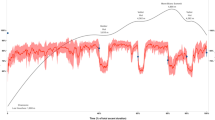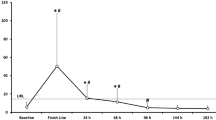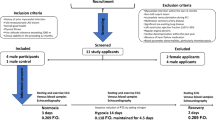Abstract
Background
It has been consistently shown that heavy exercise leads to cardiac troponin (cTn) release and variable changes in post exercise cardiac function. This relationship has not been explored at increasing or significant high altitude (HA). This study assessed the effects of exercise at progressively increasing HA on high-sensitivity (hs)-cTnT levels and their relationship to biventricular cardiac function and severity of acute mountain sickness (AMS).
Methods
Transthoracic echocardiograms, hs-cTnT levels and AMS scores were measured at rest at 1,300 m then repeated post exercise and 12 h later after progressive trekking to 3,440, 4,270 m and at 5,150 m (after trekking to 5,643 m) on 19 healthy subjects (age 35.4 ± years, 52.6 % males).
Results
There was a detectable increase (>5 ng/L) in post exercise hs-cTnT with exercise at HA which became significant at 5,150 m (5.84 % at 3,440 m, 5.2 % at 4,270 m and 56.3 % at 5,150 m; p = 0.0005). Compared with baseline, HA to 5,150 m led to a significant rise in post exercise Lake Louis AMS scores (p < 0.001) pulmonary artery systolic pressure (PASP) (23.7 ± 3.8 vs 37.9 ± 11.7 mmHg: p < 0.001), cardiac output (5.2 ± 1.2 vs 7.5 ± 1.3 l/min; p < 0.001) and a fall in SpO2 (96.1 ± vs 77.4 ± 12.0 %; p < 0.001). There was no change in stroke volume (p = 0.10) or estimated filling pressures (E/E’) of the left (p = 0.50) and right ventricles (p = 0.4). On multivariate analysis increasing cardiac output (p = 0.02) and PASP (p = 0.04) and decreasing SpO2 (p = 0.01) were the only independent predictors of increasing cTnT levels (overall R 2 = 0.23, p < 0.0001).
Conclusions
Moderate intensity exercise at significant HA influences the post exercise increase in hs-cTnT without overt deleterious effects on cardiac function.



Similar content being viewed by others
References
Twerenbold R, Jaffe A, Reichlin T, Reiter M, Mueller C (2012) High-sensitive troponin T measurements: what do we gain and what are the challenges? Eur Heart J 33:579–586
Thygesen K, Alpert JS, Jaffe AS, Simoons ML, Chaitman BR, White HD (2012) Writing group on behalf of the joint ESC/ACCF/AHA/WHF task force for the universal definition of myocardial infarction. third universal definition of myocardial infarction. J Am Coll Cardiol 60:1581–1598
Shave R, George KP, Atkinson G, Hart E, Middleton N, Whyte G, Gaze D, Collinson PO (2007) Exercise-induced cardiac troponin T release: a meta-analysis. Med Sci Sports Exerc 39:2099–2106
Shave R, Baggish A, George K, Wood M, Scharhag J, Whyte G, Gaze D, Thompson PD (2010) Exercise-induced cardiac troponin elevation: evidence, mechanisms, and implications. J Am Coll Cardiol 56:169–176
George K, Whyte G, Stephenson C, Shave R, Dawson E, Edwards B, Gaze D, Collinson P (2004) Postexercise left ventricular function and cTnT in recreational marathon runners. Med Sci Sports Exerc 36:1709–1715
Shave RE, Whyte GP, George K, Gaze DC, Collinson PO (2005) Prolonged exercise should be considered alongside typical symptoms of acute myocardial infarction when evaluating increases in cardiac troponin T. Heart 91:1219–1220
Fu F, Nie J, Tong TK (2009) Serum cardiac troponin T in adolescent runners: effects of exercise intensity and duration. Int J Sports Med 30:168–172
Tian Y, Nie J, Huang C, George KP (2012) The kinetics of highly sensitive cardiac troponin T release after prolonged treadmill exercise in adolescent and adult athletes. J Appl Physiol 113:418–425
Middleton N, George K, Whyte G, Gaze D, Collinson P, Shave R (2008) Cardiac troponin T release is stimulated by endurance exercise in healthy humans. J Am Coll Cardiol 52:1813–1814
Eijsvogels T, George K, Shave R, Gaze D, Levine BD, Hopman MT et al (2010) Effect of prolonged walking on cardiac troponin levels. Am J Cardiol 105:267–272
Neilan TG, Januzzi JL, Lee-Lewandrowski E, Ton-Nu TT, Yoerger DM, Jassal DS et al (2006) Myocardial injury and ventricular dysfunction related to training levels among nonelite participants in the Boston marathon. Circulation 114:2325–2333
Mehta R, Gaze D, Mohan S, Williams KL, Sprung V, George K et al (2012) Post-exercise cardiac troponin release is relation to exercise training history. Int J Sports Med 33:333–337
Allemann Y, Rotter M, Hutter D, Lipp E, Sartori C, Scherrer U et al (2004) Impact of acute hypoxic pulmonary hypertension on LV diastolic function in healthy mountaineers at high altitude. Am J Physiol Heart Circ Physiol 286:H856–H862
Mousavi N, Czarnecki A, Kumar K, Fallah-Rad N, Lytwyn M, Han SY et al (2009) Relation of biomarkers and cardiac magnetic resonance imaging after marathon running. Am J Cardiol 103:1467–1472
George K, Shave R, Oxborough D, Cable T, Dawson E et al (2009) Left ventricular wall segment motion after ultra-endurance exercise in humans assessed by myocardial speckle tracking. Eur J Echocardiogr 10:238–243
Naeije R (2010) Physiological adaptation of the cardiovascular system to high altitude. Prog Cardiovasc Dis 52:456–466
Naeije R, Huez S, Lamotte M, Retailleau K, Neupane S, Abramowicz et al (2010) Pulmonary artery pressure limits exercise capacity at high altitude. Eur Respir J 36:1049–1055
Dávila-Román VG, Guest TM, Tuteur PG, Rowe WJ, Ladenson JH, Jaffe AS (1997) Transient right but not left ventricular dysfunction after strenuous exercise at high altitude. J Am Coll Cardiol 30:468–473
Shave RE, Dawson E, Whyte G, George K, Gaze D, Collinson P (2004) Effect of prolonged exercise in a hypoxic environment on cardiac function and cardiac troponin T. Br J Sports Med 38:86–88
Banfi G, Lippi G, Susta D, Barassi A, D’Eril GM, Dogliotti G et al (2010) NT-proBNP concentrations in mountain marathoners. J Strength Cond Res 24:1369–1372
Ortega FB, Ruiz JR, Gutiérrez A, Castillo MJ (2006) Extreme mountain bike challenges may induce sub-clinical myocardial damage. J Sports Med Phys Fit 46:489–493
Serrano-Ostáriz E, Legaz-Arrese A, Terreros-Blanco JL, López-Ramón M, Cremades-Arroyos D, Carranza-García LE et al (2009) Cardiac biomarkers and exercise duration and intensity during a cycle-touring event. Clin J Sport Med 19:293–299
Woods DR, Begley J, Stacey M, Smith C, Boos CJ, Hooper T et al (2012) Severe acute mountain sickness, brain natriuretic peptide and NT-proBNP in humans. Acta Physiol Oxf 205:349–355
Apple FS, Jaffe AS (2012) Clinical implications of a recent adjustment to the high-sensitivity cardiac troponin T assay: user beware. Clin Chem 58:1599–1600
Hackett PH, Oelz O (1992) The Lake Louise consensus on the quantification of altitude illness. In: Sutton JR, Houston CS, Coates G (eds) Hypoxia and mountain medicine. Queen City Printers, Burlington, pp 327–330
Yock PG, Popp R (1984) Noninvasive estimation of right ventricular systolic pressure by Doppler ultrasound in patients with tricuspid regurgitation. Circulation 70:657–662
Paulus WJ, Tschöpe C, Sanderson JE, Rusconi C, Flachskampf FA, Rademakers FE et al (2007) How to diagnose diastolic heart failure: a consensus statement on the diagnosis of heart failure with normal left ventricular ejection fraction by the Heart Failure and Echocardiography Association of the European Society of Cardiology. Eur Heart J 28:2539–2550
Sade LE, Gulmez O, Eroglu S, Sezgin A, Muderrisoglu H (2007) Noninvasive estimation of right ventricular filling pressure by ratio of early tricuspid inflow to annular diastolic velocity in patients with and without recent cardiac surgery. J Am Soc Echocardiogr 20:982–988
Jurcut R, Giusca S, La Gerche A, Vasile S, Ginghina C, Voigt JU (2010) The echocardiographic assessment of the right ventricle: what to do in 2010? Eur J Echocardiogr 11:81–96
Boos CJ, Hodkinson P, Mellor A, Green NP, Woods DR (2012) The effects of acute hypobaric hypoxia on arterial stiffness and endothelial function and its relationship to changes in pulmonary artery pressure and left ventricular diastolic function. High Alt Med Biol 13:105–111
Boos CJ, Hodkinson PD, Mellor A, Green NP, Bradley D, Greaves K (2013) The effects of prolonged acute hypobaric hypoxia on novel measures of biventricular performance. Echocardiography 30:534–541
Mueller M, Celik S, Biener M, Vafaie M, Schwoebel K, Wollert KC, Januzzi JL, Katus HA, Giannitsis E (2012) Diagnostic and prognostic performance of a novel high-sensitivity cardiac troponin T assay compared to a contemporary sensitive cardiac troponin I assay in patients with acute coronary syndrome. Clin Res Cardiol 101:837–845
Gu YL, Voors AA, Zijlstra F, Hillege HL, Struck J, Masson S, Vago T, Anker SD, van den Heuvel AF, van Veldhuisen DJ, de Smet BJ (2011) Comparison of the temporal release pattern of copeptin with conventional biomarkers in acute myocardial infarction. Clin Res Cardiol 100:1069–1076
Bernheim AM, Kiencke S, Fischler M, Dorschner L, Debrunner J, Mairbäurl H et al (2007) Acute changes in pulmonary artery pressures due to exercise and exposure to high altitude do not cause left ventricular diastolic dysfunction. Chest 132:380–387
Acknowledgments
The authors would like to thank the Drummond Foundation, The Defence Medical Services and the Surgeon General’s Department for their support. The authors would also like to thank Sonosite®.
Conflict of interest
The authors have no conflicts of interest or financial ties to disclose. The Changes in BNP have been published on this cohort of patients before, however, all hs-cTnT and echocardiographic data are unpublished.
Author information
Authors and Affiliations
Corresponding author
Rights and permissions
About this article
Cite this article
Boos, C.J., Mellor, A., Begley, J. et al. The effects of exercise at high altitude on high-sensitivity cardiac troponin release and associated biventricular cardiac function. Clin Res Cardiol 103, 291–299 (2014). https://doi.org/10.1007/s00392-013-0654-2
Received:
Accepted:
Published:
Issue Date:
DOI: https://doi.org/10.1007/s00392-013-0654-2




